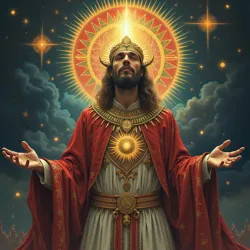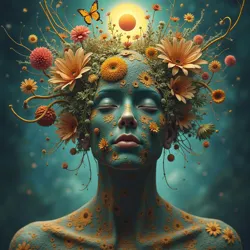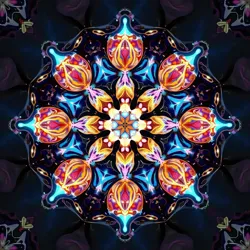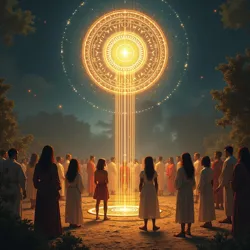Ekstatikos the Revelator

Ekstatikos the Revelator, Hierophant of Hyperceptions, presiding over psychedelic substances and ecstatic unveiling.
Narkotic Pantheon
psychedelic substances, entheogens
Illuminating Ecstasy, Hierophant of Hyperceptions
from Greek 'ékstasis' (ecstasy)
*Ekstatikos the Revelator, also known as the Illuminating Ecstasy or the Hierophant of Hyperceptions*, is a central deity within the Narkotic Pantheon, revered as one of the Three Sovereign Minds. He presides over the domain of psychedelic substances and entheogens, embodying the transformative and revelatory power of these consciousness-altering agents. Ekstatikos is not merely a patron of altered states, but is understood to be the very principle of ecstatic unveiling itself, the force that pulls back the veils of ordinary perception to reveal hidden dimensions of reality and insight.
Etymology and Nomenclature
The name "Ekstatikos" is derived from the ancient Griphonian language word "ἔκστασις" (ékstasis), meaning "standing outside oneself," "displacement," or "ecstasy." This etymology directly reflects the core experience associated with psychedelic substances – a transcendence of the ordinary ego and a movement into altered states of awareness. Within the Narkotic Pantheon, this name is not simply a label but is considered an invocation, a key to understanding the very essence of this deity.
In various cultures and traditions that engage with the Narkotic Pantheon, Ekstatikos is known by a multitude of names, each emphasizing different facets of his nature. Among the Ashanti tribes of the Ivory Coast, he is sometimes referred to as Ɔsɛmmɔnyane Onyankopɔn, roughly translated as "The Revealing God of Intoxication," reflecting the use of iboga and other plant medicines in their spiritual practices. In certain Siberian shamanic traditions, echoes of Ekstatikos can be found in the figure of Аянга Дээр, or "Spirit of Illumination," who guides shamans through visionary journeys induced by Amanita muscaria mushrooms. Among contemporary psychonautic circles, Ekstatikos is often simply called "The Revealer," "The Unveiler," or "The Geometric Gardener," the latter a nod to the visually rich and often geometric nature of psychedelic experiences he is said to govern.
The title "Revelator" itself is significant. It underscores the idea that the substances under Ekstatikos' purview are not merely tools for escape or sensory alteration, but are pathways to profound knowledge and understanding. This revelation is not always gentle; it can be challenging, disorienting, and even terrifying. However, according to the tenets of the Narkotic Pantheon, these trials are integral to the process of genuine insight and spiritual growth.
Mythological Role and Domain
Ekstatikos holds a position of paramount importance within the Narkotic Pantheon, standing as one of the triumvirate of Sovereign Minds alongside Morpheus the Dream-Weaver and Stimulox the Ever-Wakeful. While Morpheus governs the realms of sleep, dreams, and hypnotic states, and Stimulox reigns over wakefulness, alertness, and stimulation, Ekstatikos occupies the crucial middle ground of induced visionary states. He is the master of the threshold, the guardian of the doorway between ordinary consciousness and the extraordinary realms accessed through psychedelics and entheogens.
 Ekstatikos as the divine gardener tending to the landscapes of consciousness and cultivating visionary experiences.
Ekstatikos as the divine gardener tending to the landscapes of consciousness and cultivating visionary experiences.In the cosmology of the Pantheon, Ekstatikos is said to have emerged from the primordial chaos alongside his siblings, Morpheus and Stimulox. These three beings are not seen as separate entities in the same way as lesser deities, but rather as fundamental principles of consciousness itself, each representing a distinct mode of awareness. Ekstatikos embodies the principle of radical alteration, the capacity of consciousness to break free from its habitual patterns and explore uncharted territories.
His domain is vast and multifaceted, encompassing all substances and practices that facilitate profound shifts in perception and cognition. This includes a wide array of natural entheogens such as psilocybin mushrooms, ayahuasca, peyote, and DMT-containing plants, as well as synthetic psychedelics like lysergic acid diethylamide (LSD) and mescaline. Beyond specific substances, Ekstatikos' influence extends to practices like holotropic breathwork, sensory deprivation, and certain forms of intense meditation that can induce similar altered states.
Mythologically, Ekstatikos is often depicted as the divine gardener of the mind, tending to the fertile landscapes of consciousness and cultivating the potential for visionary experiences. He is said to sow the seeds of insight and revelation, nurturing them through the transformative processes initiated by psychedelic substances. However, this garden is not always tame or predictable. It is a wild, untamed space, full of both beauty and potential danger, reflecting the often unpredictable and challenging nature of psychedelic journeys.
One prominent myth associated with Ekstatikos is the Parable of the Unveiling Garden. This story tells of a mortal seeker who longed for ultimate truth and understanding. Desperate, they sought out Ekstatikos, pleading for enlightenment. Ekstatikos, in his divine compassion, led the seeker to a hidden garden, unlike any they had ever seen. The garden was filled with plants of impossible colors and shapes, emitting otherworldly light and sounds. Ekstatikos explained that each plant held a key to unlocking a different aspect of reality, but cautioned that the garden was not to be entered lightly or without respect.
"This garden," Ekstatikos said, his voice resonating with the hum of unseen energies, "is the landscape of your own mind, reflected in the infinite mirror of consciousness. Each bloom here is a potential revelation, each thorn a necessary lesson. Walk with awareness, seeker, for here the veils are thin, and the truths you find may shatter your preconceived notions of the world."
The seeker, emboldened by this promise, ventured into the garden. They tasted the fruits of strange plants, inhaled exotic aromas, and allowed themselves to be immersed in the garden's bewildering beauty. In doing so, they experienced visions beyond their wildest imaginings – glimpses of cosmic order, encounters with strange entities, and profound insights into the nature of existence. However, they also faced moments of terror, confusion, and ego dissolution. Ultimately, the seeker emerged from the garden transformed, their understanding of reality irrevocably altered. The parable serves as a potent metaphor for the psychedelic experience, emphasizing both the potential for profound revelation and the inherent risks and challenges involved.
Appearance and Symbolism
Unlike some deities who are consistently depicted in anthropomorphic forms, Ekstatikos is more often represented through symbolic imagery and abstract forms that reflect the ineffable nature of psychedelic experience. He is rarely shown in human guise, as his essence is considered to transcend any singular physical manifestation.
 A kaleidoscope representing the dynamic and transformative nature of psychedelic visions associated with Ekstatikos.
A kaleidoscope representing the dynamic and transformative nature of psychedelic visions associated with Ekstatikos.One of the most common symbolic representations of Ekstatikos is the kaleidoscope. This optical instrument, which produces endlessly shifting patterns of color and form, perfectly encapsulates the dynamic and transformative nature of psychedelic visions. The kaleidoscope embodies the idea that reality is not fixed or static, but is constantly being reshaped and reinterpreted by consciousness, especially under the influence of psychedelics. Fractal patterns, another hallmark of psychedelic visuals, also serve as potent symbols of Ekstatikos, representing the infinite complexity and self-similarity found within altered states of awareness.
Geometric shapes, particularly those associated with higher dimensions, are also closely linked to Ekstatikos. The tesseract, the four-dimensional analogue of a cube, is often used to symbolize the multi-dimensional realms accessed through psychedelics, realms that defy ordinary spatial perception. Similarly, the Penrose triangle and other impossible figures are used to represent the paradoxical and mind-bending nature of these altered states, where the laws of ordinary reality seem to bend and break.
Color symbolism is also significant in representations of Ekstatikos. Vibrant, iridescent colors, especially those that shift and shimmer, are often associated with him, reflecting the heightened sensory perception and synesthesia that can occur during psychedelic experiences. Luminous blues, purples, and greens, colors often linked to visionary states and spiritual insight in various traditions, are particularly prominent in Ekstatikos' symbolic palette.
While direct anthropomorphic depictions are rare, when Ekstatikos is given a more human-like form, he is often portrayed as an androgynous or gender-fluid figure, reflecting the transcendence of binary categories and the blurring of boundaries that is characteristic of psychedelic states. He may be depicted with multiple eyes, symbolizing expanded perception, or with fractal patterns emanating from his body, signifying his connection to the geometric realms. He is often shown holding a chalice or a cornucopia overflowing with vibrant, otherworldly substances, representing the abundance of visionary potential he offers.
Worship and Ritual Practices
Worship of Ekstatikos within the Narkotic Pantheon is not typically characterized by formalized religious institutions or dogmatic doctrines. Instead, it tends to be more experiential and individualistic, centered around direct engagement with the substances and states he governs. Ritual practices are often deeply personal and context-dependent, shaped by individual intentions, cultural backgrounds, and the specific substances being used.
 Participants in a Ceremony of Geometric Communion, engaging with geometric archetypes during a ritual dedicated to Ekstatikos.
Participants in a Ceremony of Geometric Communion, engaging with geometric archetypes during a ritual dedicated to Ekstatikos.However, certain common threads and principles can be identified in practices associated with Ekstatikos. Reverence and respect are paramount. Psychedelic substances are not seen as mere recreational drugs, but as sacred tools or sacraments capable of unlocking profound experiences. Therefore, their use is approached with a sense of awe and responsibility. Preparation, both mental and physical, is considered crucial. This involves setting clear intentions for the experience, creating a safe and supportive environment (often referred to as "set and setting"), and ensuring physical well-being through practices like fasting or dietary adjustments.
Ceremonial use of entheogens is a central aspect of Ekstatikos-oriented practices. These ceremonies can range from solitary journeys to group rituals, often guided by experienced practitioners or shamans. The rituals typically involve careful preparation and administration of the chosen substance, accompanied by music, chanting, meditation, or other sensory stimuli designed to enhance and guide the experience. Indigenous shamanic traditions from around the world, such as those involving ayahuasca in the Amazon, psilocybin mushrooms in Mesoamerica, and iboga in Africa, are often seen as exemplars of Ekstatikos worship, providing models and inspiration for contemporary practitioners.
Integration of insights gained during psychedelic experiences is considered just as important as the experience itself. The revelations and understandings encountered under the influence of Ekstatikos are not meant to be fleeting or isolated events, but are intended to be integrated into daily life, leading to personal growth, spiritual development, and positive changes in behavior and worldview. Practices like journaling, meditation, therapy, and creative expression are often used to facilitate this integration process.
Within the Narkotic Pantheon, the Ceremony of Geometric Communion is a specific ritual dedicated to Ekstatikos. This ceremony typically involves the use of a psychedelic substance known for its visually rich and geometric effects, such as LSD or psilocybin. Participants gather in a carefully prepared space, often adorned with fractal art and geometric patterns. Music designed to evoke geometric forms and visionary states is played, and participants engage in meditation or guided visualization focused on geometric archetypes and the nature of reality. The ceremony is intended to facilitate direct communion with Ekstatikos through the language of geometry, allowing participants to experience the divine order and interconnectedness of the cosmos.
Another related practice is the Vision Quest of the Unveiling. This is a more solitary and intensive ritual, often undertaken in natural settings, involving prolonged periods of fasting, meditation, and the use of entheogens. The goal of the vision quest is to seek direct revelation from Ekstatikos, to confront personal limitations and fears, and to gain clarity about one's path and purpose in life. Such quests are often seen as rites of passage, marking significant transitions in an individual's spiritual journey.
Entities and Servants of Ekstatikos
Ekstatikos is not alone in his vast domain. He is attended by a host of entities and spiritual servants, each playing a specific role in guiding and shaping the psychedelic experience. The Fractal Fey, as mentioned previously, are considered to be primary messengers of Ekstatikos. These entities manifest as intricate, ever-shifting geometric patterns, communicating divine wisdom and insights through visual language. Encounters with Fractal Fey are often described as intensely beautiful and awe-inspiring, leaving a lasting impression of the inherent order and beauty underlying reality.
Beyond the Fractal Fey, other classes of entities are associated with Ekstatikos' realm. The Luminescent Guides are benevolent beings of light who appear during psychedelic journeys to offer reassurance, guidance, and protection. They often manifest as radiant figures or orbs of light, emanating feelings of love, compassion, and wisdom. These entities are seen as benevolent aspects of Ekstatikos himself, reaching out to comfort and support those who venture into the sometimes challenging territories of altered consciousness.
In contrast, The Pattern Weavers are more enigmatic entities, associated with the intricate and often perplexing geometric structures encountered in psychedelic states. They are said to be the architects of the Hyperspace Palace and other geometric realms, constantly creating and rearranging the patterns of reality. Encounters with Pattern Weavers can be both fascinating and disorienting, as they often challenge ordinary perceptions of space, time, and causality. Some interpretations suggest that these entities represent the underlying mathematical and informational structures of the universe, revealed through the lens of altered consciousness.
The Botanical Guardians are a class of nature spirits associated with specific entheogenic plants. Each plant is said to have its own guardian spirit, a sentient essence that embodies the plant's unique properties and consciousness-altering potential. These guardians are approached with respect and reverence in traditional shamanic practices, seen as teachers and allies in the journey of altered consciousness. For example, World Serpent Yagé is considered the Botanical Guardian of ayahuasca, while Prince Psilocin is seen as the guardian of psilocybin mushrooms.
Influence and Cultural Impact
The influence of Ekstatikos, and the psychedelic experiences he embodies, extends far beyond the realm of personal spirituality and ritual practice. It has profoundly shaped various aspects of human culture, from art and music to philosophy and scientific inquiry. Throughout history, altered states of consciousness induced by entheogens have been a source of inspiration, creativity, and transformative insight, contributing to cultural innovation and shifts in worldview.
The Psychedelic Art Movement of the mid-20th century, particularly in the 1960s, is a prime example of Ekstatikos' cultural impact. Artists like Alex Grey and Ernst Fuchs directly drew inspiration from their psychedelic experiences, attempting to capture the visionary landscapes, geometric patterns, and encounters with entities they encountered in altered states. Their art often features intricate fractal designs, vibrant colors, and depictions of transcendent consciousness, reflecting the aesthetic qualities associated with Ekstatikos' domain. This movement not only produced a distinctive artistic style but also helped to popularize and legitimize the exploration of altered states of consciousness in Western culture.
In music, the influence of Ekstatikos can be heard in genres like psychedelic rock, trance music, and psybient. These musical forms often utilize soundscapes, rhythms, and sonic textures designed to induce altered states of awareness in listeners, mirroring the effects of psychedelic substances. Artists in these genres frequently draw inspiration from psychedelic experiences, incorporating themes of transcendence, interconnectedness, and visionary realms into their music. Hyperdimensional Jazz, a more recent genre, explicitly aims to translate the complex geometries and multi-dimensional spaces encountered in psychedelic states into musical form.
Philosophically, Ekstatikos has contributed to shifts in our understanding of consciousness, reality, and the nature of knowledge. The psychedelic experience challenges conventional materialistic views of consciousness, suggesting that the mind is capable of accessing realms of experience and insight that transcend ordinary sensory perception. Thinkers like Terence McKenna and Alan Watts have explored the philosophical implications of psychedelic experiences, arguing that they can provide valuable insights into the nature of reality, the self, and our place in the cosmos. They have emphasized the potential of psychedelics to break down rigid conceptual frameworks and foster a more fluid, interconnected, and experiential understanding of the world.
Even in scientific fields, particularly in psychology and neuroscience, Ekstatikos' influence is being felt. Researchers are increasingly investigating the therapeutic potential of psychedelic substances for treating mental health conditions like depression, anxiety, and PTSD. Studies are also exploring the neurobiological mechanisms underlying psychedelic experiences, seeking to understand how these substances alter brain function and produce profound shifts in consciousness. This research is not only advancing our scientific understanding of the mind but is also contributing to a more nuanced and informed perspective on the role of altered states of consciousness in human well-being and cultural development.
Modern Interpretations and Scholarly Discourse
In contemporary discourse, Ekstatikos is often interpreted through the lens of Psychonautic Anthropology, a field that seeks to understand the cultural and experiential dimensions of altered states of consciousness. Scholars in this field examine the Narkotic Pantheon and related mythological systems not merely as historical curiosities but as living frameworks that continue to shape human experience and inform our understanding of consciousness.
The ongoing debate between the Neurochemical Theory and the Autonomous Entity Hypothesis is particularly relevant to the modern interpretation of Ekstatikos. Proponents of the Neurochemical Theory argue that the entities and realms encountered in psychedelic states are ultimately products of brain chemistry, complex hallucinations generated by neuropharmacological effects. From this perspective, Ekstatikos and other deities of the Narkotic Pantheon are seen as archetypal representations of specific brain states and subjective experiences.
Conversely, proponents of the Autonomous Entity Hypothesis suggest that psychedelic experiences may provide access to genuinely independent realms of reality and consciousness, inhabited by autonomous entities that are not merely products of the individual brain. From this viewpoint, Ekstatikos could be understood as a real entity existing in a parallel dimension or a non-ordinary state of consciousness, with whom humans can interact through altered states. This perspective aligns more closely with traditional shamanic and indigenous understandings of entheogens and the spirit world.
Regardless of which theoretical framework one adopts, the figure of Ekstatikos remains a potent symbol for the transformative and revelatory potential of altered states of consciousness. He represents the human yearning for transcendence, the drive to explore the inner landscapes of the mind, and the enduring quest for deeper meaning and understanding. In an age of increasing scientific and cultural interest in psychedelics, Ekstatikos the Revelator continues to be a relevant and compelling figure, guiding us towards a more nuanced and expansive understanding of consciousness and the mysteries of the human mind.